Crypto regulation, compliance and enforcement have been the topics du jour in 2022.
Momentum for increasing government oversight of crypto has never been stronger following the collapse of Terra-LUNA, Three Arrows Capital, many crypto lending platforms and now the spectacular demise of FTX and what appears to be catastrophic fraud by its founder, Sam Bankman-Fried. Specifically for enforcement, unprecedented sanctions have been levied against smart contract addresses in the case of cryptocurrency mixer Tornado Cash.
Many jurisdictions, in the meanwhile, are making tremendous progress in establishing regulatory frameworks. The Council of the European Union has reached an agreement on markets in crypto-assets (MiCA) proposal. Like MiCA, the draft Lummis-Gillibrand bill in the United States outlines a comprehensive framework that encompasses key pillars including oversight of centralized service providers, consumer protection and stablecoins.
While draft stablecoin regulation has begun to coalesce, regulation of the broader decentralized finance (DeFi) ecosystem is still in its infancy. DeFi regulation is mostly out of scope in both European and American frameworks. As the French Central Bank deputy governor explained, “MiCA regulation is not an end in itself but rather the start of a process.”
Given the current stance and direction of the world’s top central bankers and policymakers, the industry needs to play a more active role in shaping the future of DeFi regulations. It is no longer viable to fight off regulation; instead, the industry needs to be more pragmatic, to head off the dangers of overregulation.
Where are we at now?
Central bankers acknowledge the potential for blockchain technology to improve the financial system, though they are deeply concerned about systemic risk implications and the level of risk-taking by the average consumer. These concerns, along with previous negative perceptions, were further galvanized by the collapse of FTX and the consumer harm it caused.
Regulators are still formulating a game plan for DeFi; focusing on a flexible framework and casting a wide net to meet rapid technological progress. They plan to be ready for the blockchain and beyond. Additionally, much attention is being paid to key parameters of transparency, governance and accountability.
The industry needs to take a proactive approach and take a more active role in shaping the outcome. It is no longer viable to try to hold back regulation, instead, the industry needs to be more collaborative. This is vital to head off the apparent dangers of overregulation that can become too subjective and too reliant on judgment.
How do regulators really feel?
In the opening remarks from a recent roundtable hosted by the French Central Bank, E.U. Commissioner Mairead McGuinness called tokenization (and crypto more broadly) a Wild West and warned that “those lawless days are coming to a close.” These strong words and characterization set an ominous tone for the future of DeFi regulation.
U.S. Federal Reserve Chair Jerome Powell also struck a critical tone, cautioning: “Within the DeFi ecosystem, there are very significant structural issues around lack of transparency.” Powell’s comment quickly drew the ire of industry participants who are quick to tout the transactional transparency of the blockchain. However, it is likely that Powell is alluding to the opacities in DeFi-related to personal identity, legal entity, governance, exploit risks and money laundering concerns.
These viewpoints reflect the E.U. and U.S. regulatory sentiments, with each respective government pursuing its own national policies but also organizing through supranational standard-setting bodies such as the Financial Stability Board (FSB).
As key influencers, it is no surprise that the European and American viewpoints have reverberated in FSB policy, such as the recently published consultative document for the international regulation of crypto assets. The document echoes Powell’s views on transparency, accusing decentralized technology of opaqueness and a lack of accountability.
Why is regulating DeFi so difficult?
Central bankers are not naive about the complexity and difficulty of regulating DeFi and are aware of the difficulties inherent with non-traditional legal entity structures, decentralized governance, and the anonymity of persons “in charge.”
Ravi Menon, managing director of the Monetary Authority of Singapore, commented that “pinning governance and risk management responsibility on the (right) players in the DeFi world is exceedingly difficult.” Menon then made the powerful claim that it would be hard for DeFi to exist without proper regulation applied to the proper persons, calling it a “game stopper.”
The FSB consultative document attempts to offer guidance, urging regulators to “establish ways to identify who exercises effective control on the protocol or provides access to the protocol, and to make them accountable under existing or future regulation.” However, these suggestions are difficult in practice and may suggest some level of naivete with regards to the practical implementation of DeFi regulation.
How does the industry deal with regulatory pressure?
Central authorities’ desire to control and regulate DeFi is diametrically opposed to the decentralized and pseudonymous nature of DeFi.
Perhaps the industry founder that most clearly anticipated this conflict is none other than Andre Cronje, a key figurehead of the yearn.finance (YFI) protocol and one of the most influential developers in the DeFi world.
In an interview with Delphi Digital, Cronje addressed the regulatory concern of accountability, stating, “Who’s the person [the regulators] target? It’s the founders, the devs, the lead roles in the community, eventually, it will be members on a DAO multi-sig.”
His prescient comment comes months before recent events such as the arrest of Tornado Cash developer Alexey Pertsev and the Commodity Futures Trading Commission (CFTC) charging a decentralized autonomous organization (DAO) for offering illegal trading of digital assets.
Other industry founders have also hotly debated the topic of regulation, most notably Sam Bankman-Fried’s proposal of self-regulatory standards and Erik Voorhees’ sharp response and criticism of those proposals. Bankman-Fried also lobbied for the DCCPA bill, widely seen as anti-competitive for the benefit of FTX and potentially detrimental to DeFi.
The debate shows two poles of DeFi that may emerge: one being fully compliant and regulated DeFi, the other being permissionless DeFi outside the reach of central authorities. The silver lining of this scenario is that they may not be mutually exclusive and could possibly co-exist and thrive. Users will ultimately decide where to play, each influenced by their national jurisdictions.
How might regulators approach DeFi regulation?
It is too soon to speculate on what a DeFi regulatory framework may look like, but there is much to be gleaned from discussions and comments from the world’s top central bankers.
Powell, the U.S. Fed chair, laid out the fundamental principle of a technology-neutral approach that addresses inherent risks and activities no matter where they reside, blockchain or otherwise. He states: “Some of these crypto activities resemble traditional financial activities and they need ‘same risk, same regulation’ wherever they take place.”
The FSB echoes a similar principle in its consultative document, promoting a regulatory framework that is “technology-neutral and focuses on underlying activities and risks.” In fact, the concept of “same risk, same regulation” harks back to a speech by U.S. Treasury Secretary Janet Yellen in April 2022, shortly after President Joe Biden signed the historic digital assets executive order.
It appears that regulators are planning to cast a wide net to rope in all financial activities under a regulatory umbrella no matter where they occur. Beyond blockchain, there may also be broader implications for fintech companies that offer financial services that may suddenly find themselves within the regulatory perimeter.
One of the biggest challenges for regulators will be reconciling the dissonance between principles of transparency, accountability and robust governance versus the decentralized and pseudonymous nature of many DeFi systems, some of which are governed through DAOs without clear lines of responsibility to any particular person(s).
Conclusion
Crypto, inclusive of stablecoins and DeFi, has tremendous potential to enable a parallel universe of financial services beyond the control of conventional authorities such as central banks and regulatory agencies. It is without a doubt that crypto now has the full attention of these institutions as well as governments around the world.
Blockchain technology has helped to broaden access to and redefine the meaning of financial services. Consequently, the regulatory perimeter of financial services and activity will also have to broaden and be redefined.
There is an apparent danger that regulation could become overly subjective and rely too heavily on judgment. The future of oversight will need to move away from entity-based regulation and move toward risk and activity-based regulation. Whether a person or corporation or DAO, the intention of the services being rendered will be a determining factor of whether they are inside or outside the regulatory perimeter.
The crypto industry would be served well by taking a proactive approach and using all avenues and opportunities to shape the outcome of DeFi regulation. The industry can also benefit from adopting the sentiment expressed by Ethereum co-founder Vitalik Buterin who stated, “It is up to people in the crypto community to pre-empt more adversarial situations, I am very hopeful that we can have more collaborative conversations between regulators and the industry.”





